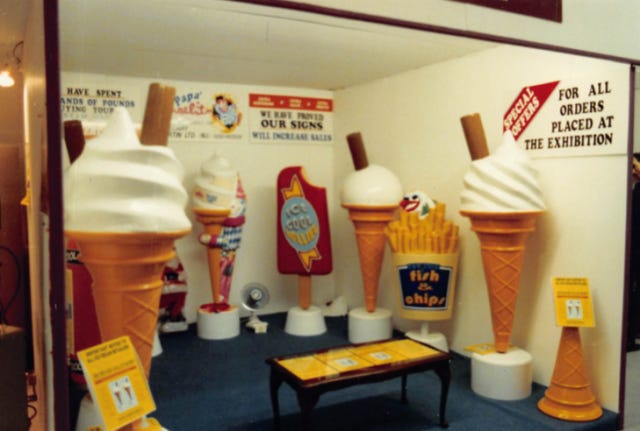The family who make giant plastic ice cream cones
If Mark Irvine’s website receives an order on a Friday night in the dead of winter, he knows he’ll probably be processing a refund come Monday morning.
If Mark Irvine’s website receives an order on a Friday night in the dead of winter, he knows he’ll probably be processing a refund come Monday morning. For the last 13 years, Irvine has worked for the business his father Gilbert established in the 1980s: Plastic Promotions, a small industrial workshop in Craigavon, Northern Ireland that “cranks out” giant plastic ice cream cones. You’ve undoubtedly seen one. They’re normally sat outside newsagents or seaside shops – you can sometimes spot a smaller one atop your local ice cream van. Irvine’s work is seasonal, and by December, his only customers are “drunk people on a Friday night” and “eccentric interior designers.”
Still, the work remains steady year-on-year. “We don’t really promote ourselves that much,” Irvine says. “We’ve no competition, obviously – it’s not a saturated market, the giant ice cream cone manufacturing industry.”
Mark's cousin Matthew in 2008, photograph courtesy of Mark Irvine
Giant plastic promotional ice cream cones have been scattered across the UK’s streets for decades, but how exactly did they get there, and where exactly do they come from? We are so used to the myriad of strange plastic items in our lives – Christmas cracker toys; those water-filled rubbery tubes that you’d get in the gift shop after a particularly good school trip – that we rarely stop to question who makes these objects and how they feel about their work.
“It is weird,” Irvine, 33, concedes when asked if he’s gotten used to his job or is still occasionally struck by strange nature of his craft. There are only four members of staff in the Plastic Promotions workshop, so Irvine does a bit of everything – answering the phone, travelling to exhibitions, loading the machines that whir robustly in the background as he speaks.
The family business began in 1988 with a single giant cone. Irvine’s uncle had bought a soft serve machine for his petrol station, but quickly discovered that customers weren’t noticing it in the corner of his shop. He asked his brother Gilbert – an engineer – to create a large plastic cone to advertise his wares. “It quadrupled his ice cream sales,” Irvine says now, “So [my dad] started making these and he started going to exhibitions for ice cream retailers, and it started to take off then.”
Gilbert Irvine, photograph courtesy of Mark Irvine
What exactly is the start-to-finish process of making a giant plastic promotional ice cream cone? “Okay, well it’s a flat sheet,” Irvine explains, “and then it’s vacuum formed and the two vacuum formed shells are then welded together. Then it’s put into the spray booth.” In a video Irvine sends from the workshop, it’s amusing to catch glimpses of employees wheeling 6ft pure-white Mr Whippys across the floor, a giant Twister floating in the rafters, and a row of half-sprayed 99s in the painting room.
Plastic Promotions have six different cone moulds – the first was carved out of wood by Gilbert, who Irvine says is “good with his hands.” In fact, the machine Gilbert built to make his first cones is the one the company still use today – it is a repurposed slurry tanker, an old piece of farm equipment. “It’s humble enough I suppose, but it’s very customised equipment: we built it ourselves specifically for making that product.”
Illustration by Karolinka Designs
The giant cones on the Plastic Promotions website will set you back anywhere between £150 and £372. Around half of the company’s customers are small independent shops, while the other 50% are chain stores, ice cream equipment manufacturers, and ice cream brands. In 2016, Unilever placed a large order to celebrate the launch of its Mangum Double – the brand ordered 200 giant Magnums, 200 giant Twisters, and 50 giant Cornettos. Four years before that, luxury fashion company Mulberry purchased a batch of cones to line its catwalks and shop windows. In 2007, a Plastic Promotions cone was even photographed to be featured on a postage stamp.
Irvine and his team produce roughly 15 cones a day (“It’s held up with the paint curing process,” he explains) but when working overtime, they can make as many as 25. In the average summer, Plastic Promotions sell 700 cones. The work is highly seasonal – orders start in February, boom in the spring, and tail off in mid-August. Winter sees the aforementioned drunk orders (“A pain in the butt” thanks to returns) along with the occasional person who buys a cone for their garden. “We used to do giant keys for locksmiths and we used to do giant fish for fish and chip shops, but we never really sold any, it was always the cones.”
When Gilbert Irvine ran the family business, he would make all of his money in the summer and would stretch his earnings over the winter. Since then, his sons have helped diversify the company (Mark’s brother John does the business’s bookkeeping), and they now sell car crates for dogs, too. For a few months during the national lockdown implemented due to the coronavirus pandemic, the company also began crafting protective plastic shields for shop counters and hospitals.
An early exhibition, photograph courtesy of Mark Irvine
Is it possible that the promotional plastic ice cream market will soon be saturated? Irvine says he once saw a Plastic Promotions cone on the street and realised it was over 25 years old (he could tell because it featured an old version of the company’s sticker). With such sturdy cones, can the Irvines maintain customer numbers year after year? Surely there are only a limited number of people who want (or need) a 6ft scoop of vanilla with a plastic Flake?
“If we were better at marketing, I suppose it would grow every year, but yeah, it just seems to always be okay,” Irvine says. “It’s something I have thought about but it’s yet to be a problem – maybe in the next couple of years? But for the past 30 years, it’s been fine.”
If you enjoyed this story, please consider leaving me a tip at: www.paypal.me/AmeliaTait. The Waiting Room is a space for slightly sillier stories during the Covid-19 crisis.
Via PayPal, I hope different people can donate at different times depending on whether a story resonated with them. Whether 10p or £10, I am grateful for your contribution!
♥ Logo by Karolinka Designs










